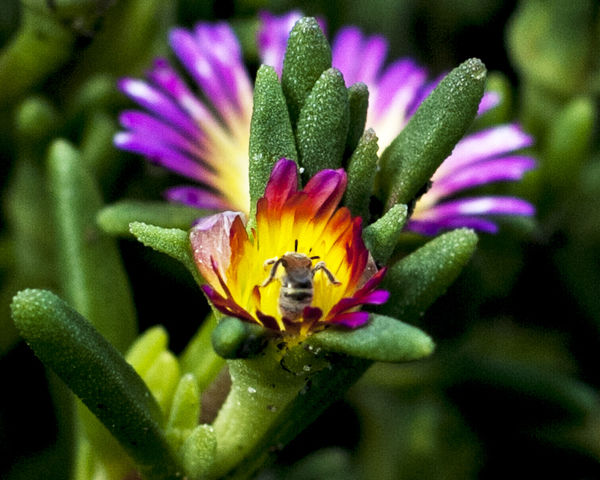Which lens for which type of photography?
Oct 29, 2018 21:36:48 #
Newly registered UHH member but have been reading the posts for the last couple months to get up to speed. Used point and shoot for many years and recently bought a Canon T6 that came with 3 lens. I kind of understand the basic premise of a telephoto lens to bring in distant views but which lens carries weight with which type of photography in general? Or can you universally use any lens for any type of shot? Not looking for drawn out specifics - just general guidelines on which lens you think is appropriate for a specific type of shot. The three lenses I have are the 75-300 and 18-35 and a nifty fifty.
Oct 29, 2018 22:06:14 #
Nifty fifty for low light without flash or shallow depth of field with the aperture wide open. Good for portraits or any subject with a shallow depth of field. It's also a very sharp lens so you can do some deep cropping with it. See the attached shot taken with my nifty fifty of a gnat in a tiny flower bud. The gnat is about 1/8th inch long and 1/16th inch wide. The gnat just looked like a small piece of dark string with the naked eye.
75-300 (telephoto) at the 300 end can use it for birds or squirrels. With the variable zoom can do close ups of flowers or pets, whenever you want to fill the whole frame with the subject without having to get too close.
18-35 (wide angle) for landscapes or architecture or room shots. Also for group shots to get the whole group in the shot.
75-300 (telephoto) at the 300 end can use it for birds or squirrels. With the variable zoom can do close ups of flowers or pets, whenever you want to fill the whole frame with the subject without having to get too close.
18-35 (wide angle) for landscapes or architecture or room shots. Also for group shots to get the whole group in the shot.
Oct 29, 2018 22:10:29 #
I don't disagree with Bob.
Another approach is to put one lens on, the 35 or 50, and go shooting. Let the results guide you. You may wind up with a unique point of view.
--
Another approach is to put one lens on, the 35 or 50, and go shooting. Let the results guide you. You may wind up with a unique point of view.
--
Oct 29, 2018 22:18:55 #
A good place to start might be to recognize the field of view (often mistakenly termed “equivalent focal length”) of your lenses. The Canon T6 features a 1.6x “crop sensor” mount. So your 50mm actually has an FOV equal to 80mm. Your 18-35mm has an FOV equal to 28.8-56mm. Your 75-300mm actually has an FOV equal to 120-480mm. Each of these lenses can be used for any type of photography - there are no hard and fast rules for their use. It is up to you to decide how well each lens will capture the scenes you are shooting. Other factors include the max. aperture (speed) and the weight (bulk) of each lens. You can get a lot of guidance by taking time to practice with each lens and by watching example videos created by vendors and YouTube bloggers. Best wishes on your photographic journey.
Oct 29, 2018 22:19:49 #
I have tried putting the different lenses on and taking some shots with mixed results. Was just looking for a general starting point to help me until I get more familiar with this cam. The last 6 weeks have been a whirlwind of learning the basics like the exposure triangle, compensation, DOF, white balance, etc. Watched a 100+ YouTube vids and am a member of photography info forums and am gaining knowledge from them every day.. It has been a blast but there is DEFINATELY a learning curve involved! <big grin>
Oct 29, 2018 22:21:10 #
Oct 29, 2018 22:22:30 #
Oct 29, 2018 22:51:58 #
Strodav
Loc: Houston, Tx
Welcome to the forum. Cambridgeincolour.com is an excellent resource from beginning to advanced photography on almost every topic. Here is an article on everything you want to know about lenses. It has a very good section on controlling perspective by focal length. At the bottom it references articles on how to use wide angle, telephoto, and macro lenses.
https://www.cambridgeincolour.com/tutorials/camera-lenses.htm
https://www.cambridgeincolour.com/tutorials/camera-lenses.htm
Oct 29, 2018 23:00:45 #
Cavik wrote:
Newly registered UHH member but have been reading ... (show quote)
Welcome!!!
What do you like to photograph? That would help us better.
Oct 29, 2018 23:11:54 #
Cavik wrote:
Newly registered UHH member but have been reading ... (show quote)
I kind of doubt you have an 18-35mm lens with the T6, (typo?). its more likely the 18-55mm IS kit lens, which is quite good for general purpose outdoor shooting. The 75-300mm gives you more "reach" to bring distant subjects closer but has no IS which makes it more difficult to hand hold at the long end. Neither are very good indoors with your 18MP crop sensor body. The 50mm F1.8 lens is MUCH better in low light, i door shooting or when your want a larger aperture to create shallower depth of field.
Do not concern yourself with "crop factors" as it will get confusing and irrelevant. Suffice it to say that "what you see is what you get" when looking through your viewfinder.
Oct 29, 2018 23:18:31 #
Unless you are doing some kind of specialized photography such as astrophotography or birds in flight you can use any lens for any type of photography. For example sports photography is generally done with big telephoto lenses, but some of he most iconic sports photos ever were taken with wide angle lenses.
Landscape photography may look more natural taken with a lens in the 50mm to 70mm range, but there are great shots that have been taken with 12-24 wide angle lenses and with 300mm lenses. What lens you use will depend largely on what lenses you have available and what style you wish to shoot.
For example with a wide angle lens such as your 18-35 you can get everything from two feet in front of the lens to infinity into focus showing incredible depth of field, but if you do that the perspective will look unnatural. On the other hand you can shoot the same subject, lets say distant mountains with a big telephoto compressing the distance and making the mountains much more significant in the photo.
Portrait photos are often taken with lenses in the 85mm range, but there have been great portraits taken with both wide angle and larger telephoto lenses.
Use the lenses that you have to shoot the images that you envision. Then if you find yourself most often shooting with a specific focal length or finding that you need a specialty lens for something that you especially want to shoot then save money to acquire the specific lens that you need. Equipment can be very important, but the reality is the best lens is the one that is on your camera when you are ready to shoot.
Landscape photography may look more natural taken with a lens in the 50mm to 70mm range, but there are great shots that have been taken with 12-24 wide angle lenses and with 300mm lenses. What lens you use will depend largely on what lenses you have available and what style you wish to shoot.
For example with a wide angle lens such as your 18-35 you can get everything from two feet in front of the lens to infinity into focus showing incredible depth of field, but if you do that the perspective will look unnatural. On the other hand you can shoot the same subject, lets say distant mountains with a big telephoto compressing the distance and making the mountains much more significant in the photo.
Portrait photos are often taken with lenses in the 85mm range, but there have been great portraits taken with both wide angle and larger telephoto lenses.
Use the lenses that you have to shoot the images that you envision. Then if you find yourself most often shooting with a specific focal length or finding that you need a specialty lens for something that you especially want to shoot then save money to acquire the specific lens that you need. Equipment can be very important, but the reality is the best lens is the one that is on your camera when you are ready to shoot.
Oct 29, 2018 23:39:52 #
You are quite right MY Shooter - I get fingered my message and the lens is in fact the 18-55 out lens not a 18-35. Regular shots are ok but I am getting into this camera to do more creative shots like heavy bokeh, light trails, long exposure Star fields and softening water features. The techniques and science behind the light manipulation to create these shots are a heavy draw for me. Just need to get the basics down before forging into the battlefield. I have seen many posts from many members and the pics are incredible. Thanks to everyone for posting pics and giving us engineers the encouragement to push through the learning curve. And a big thank you to strodav for the link to a great resource!
Oct 29, 2018 23:44:44 #
Cavik wrote:
You are quite right MY Shooter - I get fingered my... (show quote)
Look for local camera clubs to join, peer education is invaluable. Also check for local adult education classes, they are usually inexpensive and quite informational.
You have lots of good questions and answering them all here would take many pages and many days.
Good luck in your venture!
Oct 30, 2018 06:45:45 #
The 24-105mm zoom lens covers a lot of photography as a general purpose (or utility) lens. For a longer reach, consider the 100-400mm telephoto lens. For a wider reach, consider lenses that cover the spread from 10 or 12mm at the low end to around 24mm.
These three lenses would serve all (or nearly all) your photography needs.
But if you intend to do close-up or macro photography, then consider a prime lens for that purpose.
As a rule, the field of photography dictates the lens to use.
Note that adjustable focal length lenses have improved to where they pretty much equal prime lenses in image quality. Unless you have speciality needs, adjustable lenses will serve your photography needs.
These three lenses would serve all (or nearly all) your photography needs.
But if you intend to do close-up or macro photography, then consider a prime lens for that purpose.
As a rule, the field of photography dictates the lens to use.
Note that adjustable focal length lenses have improved to where they pretty much equal prime lenses in image quality. Unless you have speciality needs, adjustable lenses will serve your photography needs.
Cavik wrote:
Newly registered UHH member but have been reading ... (show quote)
Oct 30, 2018 06:51:43 #
billnikon
Loc: Pennsylvania/Ohio/Florida/Maui/Oregon/Vermont
Cavik wrote:
Newly registered UHH member but have been reading ... (show quote)
75-300, sports, portraits, distant views can be compressed with this lens
18-35, generally a landscapes, allows you to include a foreground and background in same shot, tight interiors, group shots
Nifty Fifty (by the way I hate that description) use for low light photography, can also be used for portraits, HINT (shoot wide open on portraits, (smallest number, 1.8, 2. 2.8 and blur the back ground on your portraits) always, always, focus on the eyes.
If you want to reply, then register here. Registration is free and your account is created instantly, so you can post right away.







